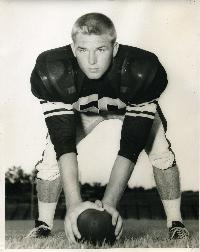
Bob Crenshaw
The Crenshaw Award
By Jim Joanos
The Player With The Biggest Heart
At the end of each football season, the Crenshaw Award is presented to the FSU "player with the biggest heart." It is one of several awards that are presented to individual players who have played important roles during the season. The most valuable players on both the defense and the offense are rewarded with plaques. The official captains are declared and there are some other trophies given. However, the announcement that I look forward to the most at the annual banquet is the winner of the season's Crenshaw Award.
There are several reasons why the Crenshaw Award gets my attention. First, the award is named for one of the finest people that I have ever known. Second, the purpose of the award is to recognize those who have overachieved and by doing so, have inspired others to overlook their own shortcomings and handicaps and to set their standards high. And finally, it has historically been awarded to some really fine people who proved their worthiness in later years by becoming successful in their paths through life in similar manner to their achievements when they wore the Garnet and the Gold. I know of no award that better exemplifies the very essence of FSU's football history than an award for overachieving because that is what FSU's football has been about during most of its history, overachieving.
 |
Bob Crenshaw |
Bob Crenshaw was one of the best representatives of what FSU football should be all about as a football player. He was not very big. He was not very fast. But what he did have was the "biggest heart" on the team. When he played, the rules limited substitution, so the players had to play both on offense and defense. When he played in the early fifties, he was the smallest starting center on any major college football team in the country. He played linebacker on defense. In 1955, his senior season, the game programs listed him as weighing 165 pounds. We used to laugh at that as he did not weigh that much. Despite his size, he excelled as a player and as a senior was chosen by his teammates as a team co-captain.
Cren did a lot more than play football at FSU. He was our class president for both our junior and senior years. He was an honor student and a very active member of the Wesley Foundation for Methodist students. Cren was also vice president of Omicron Delta Kappa, the campus scholarship-leadership honorary, as well as his college fraternity, Alpha Tau Omega. In his senior year, he was named to the FSU Student Hall of Fame. At graduation time, we elected him Permanent Class President of the FSU Class of 1956. There was no competition, he was the clear favorite to be our future leader.
Ron Schomburger, who played at FSU with Cren, describes him as one of the most positive people that he has known. Schomburger says that "whether things were good or bad, he always looked at the bright side" and adds that "also in every circumstance, he was always a gentleman."
At FSU, Cren was also an honor cadet in the Air Force Reserve Officers Training Program. Upon graduation, he entered the Air Force's flight training program. A year later, he had earned his pilot wings. A year after that, in 1958, at 24 years of age, Lieutenant Crenshaw died in an Air Force plane crash in the woods near Chiefland, not very far from Tallahassee where he had played so courageously.
Although Cren died nearly a half century ago, his influence continues. For some of us, nearly every time we go into Doak S. Campbell Stadium, we feel his presence. As a player as well as a student leader, he used to talk about his desires that FSU would develop tradition and become one of the nation's finest programs. He would be most proud of what FSU has become. In 1982, Crenshaw was posthumously named to the FSU Athletic Hall of Fame.
The inscription on the plaque awarded each year bears the words that it is presented "To the Football Player With the Biggest Heart." Those are well suited words to describe the person selected each year by the members of the team to the player among them who "best exemplifies the qualities that made Bob Crenshaw an outstanding player and person." The award in Cren's honor was established immediately after his death and was first awarded at the end of the 1958 season. Although the winner of the award is announced at the annual team banquet following each season, the plaque itself is presented to the recipient by the Tallahassee Quarterback Club at its annual Jamboree Banquet held in February.
The stature of the Crenshaw Award has been enhanced through the years by the quality of the men who have received it. Some of FSU's finest student-athletes have been recognized. In all, 49 players have received the award through the years.
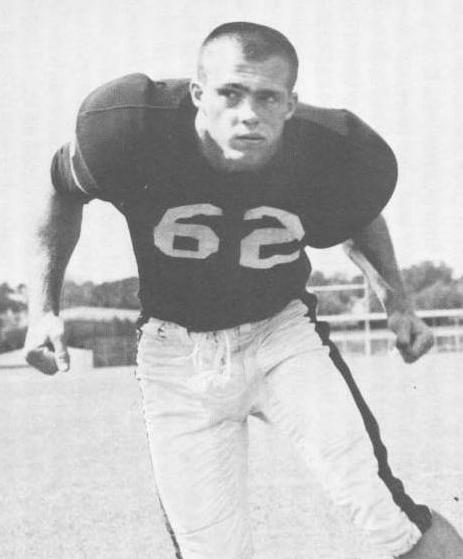 |
Al Ulmer |
Al Ulmer, who played guard at FSU, was the first recipient of the award. He received it as a junior following his first two seasons on the varsity, 1957 and 58. In both of those two years, Ulmer was recognized on the first team of the All-Florida college team. He was also an AP and UPI honorable mention All-American after the 1958 season, despite only being 5-10 and weighing 176 pounds. It was the 1958 team that went 7-3 during the regular season and played in the one and only Bluegrass Bowl. That was the same team that beat Tennessee 10-0 for FSU's first ever win over a Southeastern Conference team. Known as a "watch charm" guard, Ulmer went on to become a co-captain of the 1959 team. Although, the 1959 team, under one year head coach Perry Moss, went 4-6, Ulmer, on three separate occasions, was named the State of Florida's lineman of the week and at the end of the year, UPI Honorable Mention All-American. Like Crenshaw and the others of the fifties, he played both ways because of the limited substitution rules.
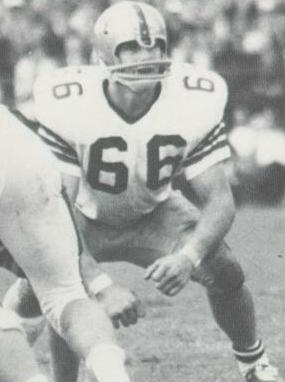 |
Dick Hermann |
Dick Hermann, a linebacker, won the Crenshaw Award following FSU's first great season of 1964. That was the year that FSU went 8-1-1 during the regular season which included the first ever modern day victory over Florida, and then destroyed Oklahoma in the Gator Bowl, 36-19. A member of the famed defensive group known as the "Seven Magnificents," Hermann was one of the best early linebackers to play at FSU. When Bill McGrotha wrote his very special history book entitled, Seminoles! The First Forty Years, he included an All-Time Team chosen by former Assistant Coach Bob Harbison who coached FSU players in 37 of those first 40 years. Hermann was listed as one of the two linebackers chosen. In 1985, Hermann was admitted into the FSU Athletics Hall of Fame.
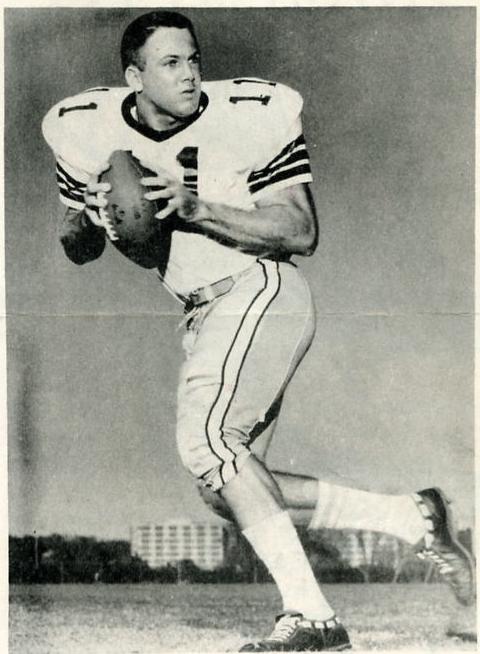 |
Kim Hammond |
Kim Hammond, following the 1967 season, was the first quarterback to be awarded the Crenshaw plaque and how fitting it was for him to be deemed as the "player with the biggest heart." His performance that season was amazing. He started the season in a backup role, but gained prominence in the second game of the season when given a chance to start, he led the Seminoles to an amazing 37-37 tie with the Bear Bryant coached Alabama team. Hammond topped that courageous performance when in the last game of the season, he led FSU to a 21-16 victory over the University of Florida. Hammond had helped the team to an early 14-3 lead, but was knocked unconscious and had to leave the game on a second quarter play in which photographs later showed he had been pulled to the ground by his facemask. By the fourth quarter, with Hammond out, Florida had decreased the gap to 14-9 and had the momentum going in its direction. Then, in dramatic fashion, Hammond reached clarity, and reentered the game with FSU on its own eight yard line. In three plays, two of which were 51 and 41 yard pass plays to Ron Sellers, Hammond had the Noles in the Florida end zone and again in command of the game. The Seminoles ended the year playing Penn State in the Gator Bowl. That game also ended in dramatic fashion with Penn State dominating the first half 17-0. Then in the third quarter, Joe Paterno's Penn State team gambled and lost deep in its own territory when he chose to go for it on fourth down and inches. The Seminole defense held and the offense under Hammond's leadership took over and controlled the remainder of the game which ended in a 17-17 tie.
Hammond was named as a second team All-American on both the AP and UPI squads, in addition to receiving the Crenshaw Award at the end of the 1967 season. He was drafted by the Miami Dolphins in the 6th round and was with them for one year followed by three seasons with the Boston Patriots, 1968-70. In the off season, he attended law school at FSU and upon graduation practiced law in Daytona Beach until 1979 when he became a judge. Circuit Judge Hammond of Florida's Seventh Judicial Circuit, is a past Chief Judge of the circuit, and now works out of the Flagler County Courthouse in Bunnell. A popular speaker, he has had a major role in judicial education and has given a great deal of effort to the programs aimed at making Florida judges better. In 1978, Kim Hammond was a member of the second class admitted into the FSU Athletics Hall of Fame.
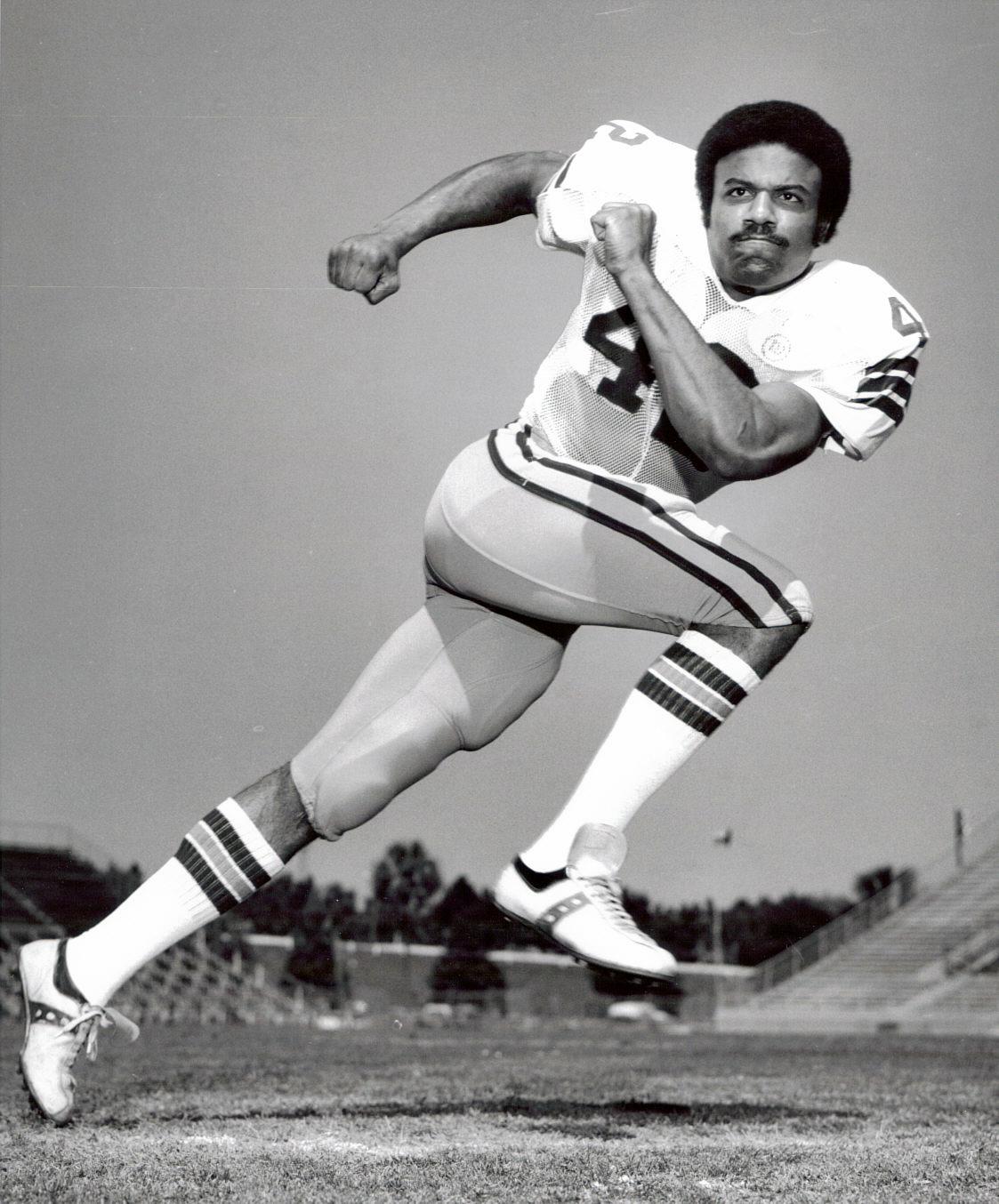 |
Joe Camps |
Joe Camps, a safety, who received the award following the 1976 season, is one of my all time favorites among the recipients. Camps, a high school honor student who was the first black student body president in the history of Gainesville High School, was signed to come to FSU in 1973 by head coach Larry Jones. Shortly after he committed to FSU, the Seminoles went through one of the lowest points in the team's history. It included a large number of players either leaving the school or quitting college football, a scathing three-part series of articles printed by the St. Petersburg Times criticizing FSU's off season training program, a 1973 season, Camps' freshman year at FSU, in which the team went 0 and 11, and the firing of the head coach. Consequently, Camps played for head coach Darrell Mudra, in his second and third years as a Seminole. In his sophomore year, the team managed only one victory which was over the University of Miami and went 1-10. In that lone win, Camps made a key interception late in the game that was most important in FSU retaining its 21-14 lead and the victory. In his junior year, the team improved to a record of 3-8 and had a number of very promising underclassmen, and sported some optimism. But it was not enough and Mudra was let go. Consequently, when Bobby Bowden came in as head coach for the 1976 season, Camps played for his third head coach in four years.
Prior to the 1976 season, Camps was elected one of four team captains for the upcoming season. Camps went on to play a major role in FSU's 5-6 season in which the team won its last three games of the season and began Coach Bowden's legendary tenure. At the end of that season, the coaches awarded Camps the Crenshaw award for his attitude and accomplishments. He says that the award for the "biggest heart" has been very meaningful to him "because you take fight to everything that you do every day."
After football at FSU, Camps went on to become a physician, obtaining his medical degree at the University of Florida and doing his residency specializing in Urology at the University of North Carolina (Chapel Hill). At UNC, he was awarded the Womack scholarship award, the highest award given to a surgical resident. He came back to Tallahassee in 1990 and has practiced here ever since. He currently serves as one of the principal physicians of the Southeastern Urological Center in Tallahassee. He has continued to give back to FSU in a number of ways including being the 1997 National Chairman of Seminole Boosters. In 2000, based upon many years of service to FSU athletics, he was presented the Moore-Stone award and made a member of FSU's Athletics Hall of Fame.
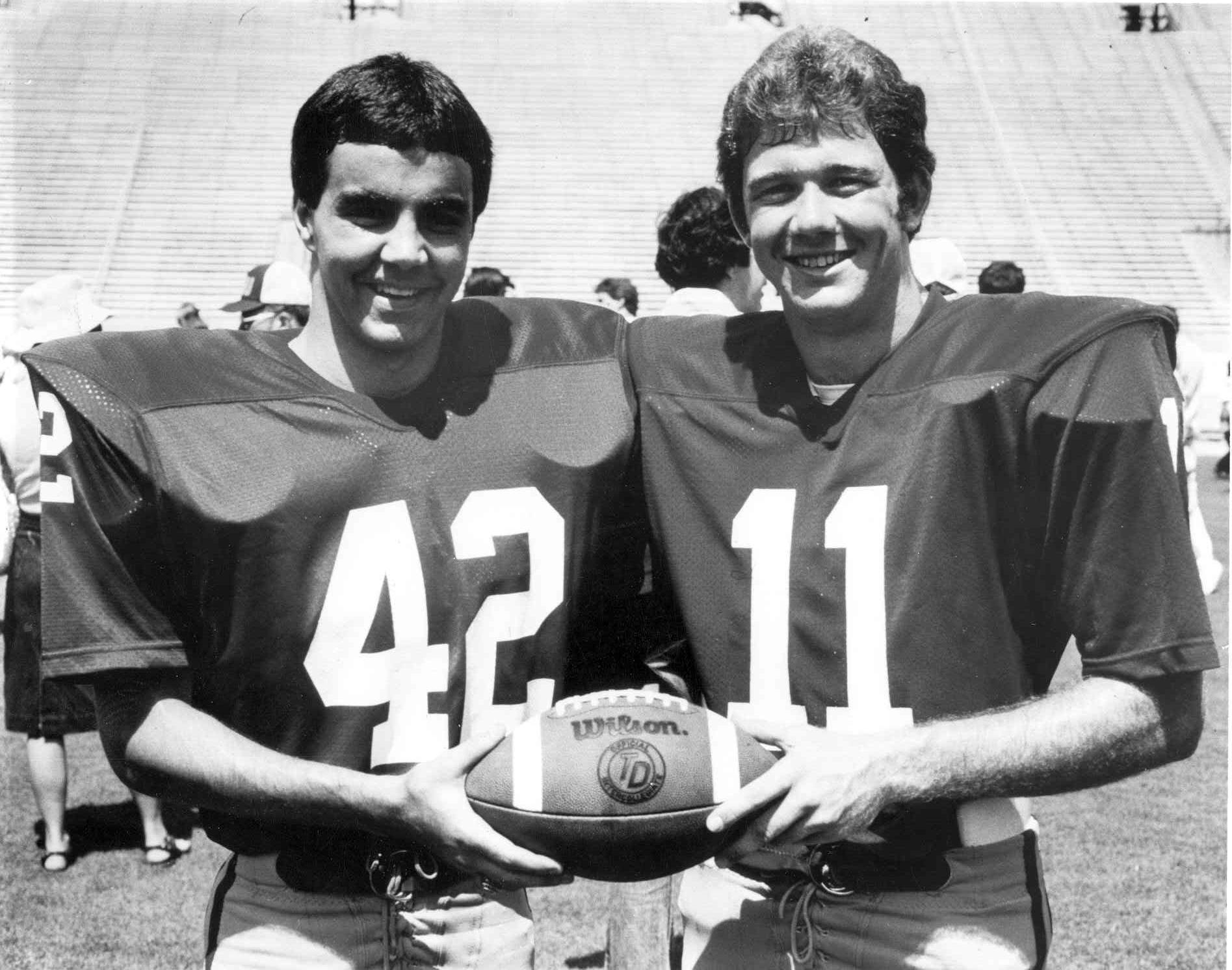 |
Monk Bonasorte and Rick Stockstill |
Francis "Monk" Bonasorte, a safety, was presented the Crenshaw Award after the 1980 season. Bonasorte's career at FSU reads like a "Cinderella story." He came to FSU in the Spring of 1977 as a walk-on seeking to be a tight end for FSU. Despite being slow afoot (:05.04 forty), he not only earned a scholarship but became an All-American at safety (3rd team AP in 1979 and 2nd team FN in 1980) after suffering a serious knee injury requiring surgery late in the 1978 season. He was noted for the intensity that he put into his study of upcoming opponents. One of the coaches once described him as "like having a coach on the field." Bonasorte was also noted for always being where the ball was. Bonasorte tied the FSU record for most passes intercepted in a season (8 in 1979) and set it for passes intercepted in a career (15 from 1977 to 80). Both records stood until Terrell Buckley broke them both in 1991. In 1995 Baonasorte was inducted into the FSU Athletics Hall of Fame. He is the current Executive Director of the FSU Varsity Club.
Bonasorte recently said that when he "first got the award," he "did not know the significance of it or anything about Crenshaw." After he learned about "Crenshaw, who he was and what he did as well as how he died, the award took on a lot of significance to me."
Blair Williams was the second and last quarterback to receive the award when it was awarded him after the 1982 season. During most of his time at FSU, Williams was a backup quarterback. Finally, in his senior season through persistence and hard work he became a starter. But even then, he shared quarterbacking duties with Kelly Lowrey during the regular season. However, in the final game of his career, he left his mark forever on FSU football history as he was a vital component and one of the FSU stars in a 31-12 victory over West Virginia on a cold and rainy night in Jacksonville's Gator Bowl at the end of the season. Williams got the start in the Gator Bowl game because of the weather conditions. In earlier practices and games, the coaching staff had learned that Williams could be an effective passer even when it rained. As a result, when rain set in, Williams was chosen to start. The strategy paid off. During the game, despite the conditions, Williams, operating mainly out of the shotgun formation, completed 16 of 30 passes for 204 yards and one of FSU's touchdowns in helping the Seminoles attain the victory. It was a very gusty performance and one that many of us remember vividly.
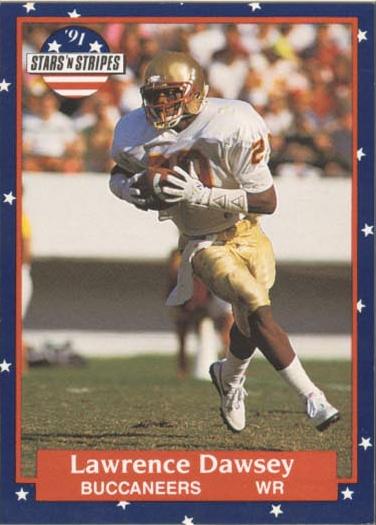 |
Lawrence Dawsey |
After the 1990 season, Lawrence Dawsey, was awarded the Crenshaw award. In 1989, he had been a member of the famous FSU "Fabulous Four" group of wide receivers. After the others had exhausted their eligibility, Dawsey came back for another year. Throughout his senior season, he was not only the team's leading receiver but maintained a major leadership role as well. He was regarded as a "blue-collar receiver" who was not particularly fast but who "got the job done." As a result, at the end of the season, he was an Associated Press and Football Writers Association first team All-American selection and made a number of other all star lists as well in addition to beging designated as the Seminole that year "with the biggest heart."
Dawsey went on to play eight years in the NFL, the first five of which were with the Tampa Bay Buccaneers. In 1997, he was inducted into FSU's Athletics Hall of Fame.
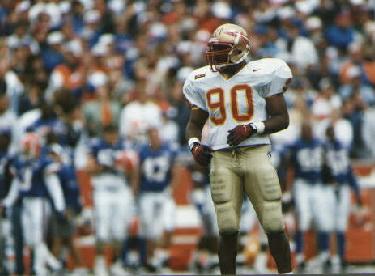 |
Greg Spires |
Greg Spires, a four year letterman and the Crenshaw recipient following the 1997 season, played nose guard, linebacker and finally defensive end during his tenure at FSU. Most expected him to be one of the stalwarts of the Seminole defense going into his senior season. Unfortunately, a broken fibula caused him to miss the first three games of the season. When he did get into the lineup, he made up for lost time. By season's end, he had totaled 32 tackles, including 10 for losses, and was selected a second team All ACC player in addition to winning the award for the player with the biggest heart. Spires has gone on to prove his toughness and determination in the National Football League. He was drafted by the New England Patriots in the third round (83rd overall pick) of the 1998 draft, and played with that team for three seasons, then spent one with the Cleveland Browns. In 2002, he was traded to Tampa Bay and has been an outstanding defensive lineman with that organization ever since. He is currently in his ninth season in the NFL, a major feat in itself.
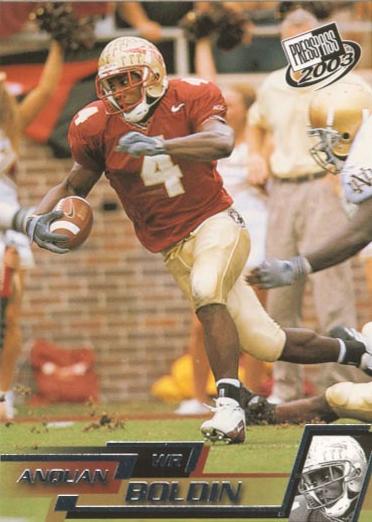 |
Anquan Boldin |
Anquan Boldin, a wide receiver, won the award following the 2002 season. He was a most fitting recipient of the award. In the Fall of 2001, Boldin had suffered an excruciating injury when he tore his ACL in a knee. He missed a season with the injury, spending the entire year rehabbing the knee. However, with a lot of effort, he made it back and had a great year in 2002. For his efforts that season following the injury he not only got the FSU Crenshaw Award but the Atlantic Coast Conference presented him with the Brian Piccolo Award, which is awarded each year to the "most courageous player" in the conference. Fans well remember his gutsy performance in his last game as a Seminole when he had to play quarterback for the first time since high school. It was in the Sugar Bowl against the University of Georgia.
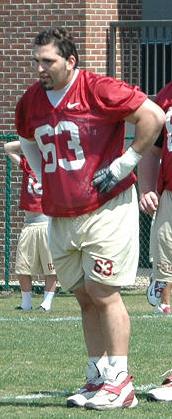 |
David Castillo |
After the 2003 season, the award was given to David Castillo, a second year letterman. Castillo, like Crenshaw, played center for Florida State. During the 2003 season, Castillo played virtually the entire season with not only a broken foot but an injured arm that refused to heal. After attaining the award, he went on to play two more years through the 2005 season despite numerous injuries that continued to plague him. Also similarly to Crenshaw, he was an outstanding student and graduated as a biology major carrying a scholastic average well over 3.5 and attained numerous academic awards. For three consecutive years, 2003-05, he was an All-ACC Academic selection and after his final 2005 season, he was a second team Academic All-American and was awarded an NCAA post-graduate scholarship. Currently, he is working for the Seminole Boosters while awaiting word on his application for admission to medical school as he maintains his longtime dream to become a physician and in time an orthopedic surgeon.
When this season ends, the award will be presented again. Who will get it? Will it be someone who has already excelled at overcoming obstacles or will it be a hero that will emerge in the latter stages of this season?
Whoever it is, will be filling some mighty big shoes. Bob Crenshaw and the 49 players who have received the award have set the standards very high.
I look forward to finding out who the guy on this team is "with the biggest heart."
| 1958 Al Ulmer 1959 Ramon Rogers 1960 Abner Bigbie 1961 Paul Andrews 1962 Jim Sims 1963 Larry Brinkley 1964 Dick Hermann 1965 Howard Ehler 1966 Ed Pope 1967 Kim Hammond 1968 Billy Gunter 1969 Stan Walker 1970 Bill Lohse 1971 Bill Henson 1972 David Snell 1973 Steve Bratton |
1974 Jeff Gardner 1975 Lee Nelson 1976 Joe Camps 1977 Aaron Carter 1978 Scott Warren 1979 Greg Futch 1980 Monk Bonasorte 1981 Barry Voltapetti 1982 Blair Williams 1983 Ken Roe 1984 Todd Stroud 1985 Pete Panton 1986 Greg Newell 1987 Mark Salva 1988 Jason Kuipers 1989 Tony Yeomans |
1990 Lawrence Dawsey 1991 Dan Footman 1992 Robbie Baker 1993 Jon Nance 1994 Steve Gilmer Enzo Armella 1995 Todd Rebol 1996 Connell Spain 1997 Greg Spires 1998 Troy Saunders 1999 Reggie Durden 2000 Patrick Newton 2001 Bradley Jennings 2002 Anquan Boldin 2003 David Castillo 2004 Bryant McFadden 2005 Andre Fluellen |